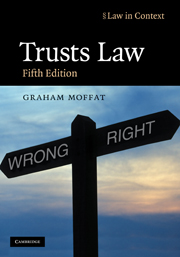Book contents
- Frontmatter
- Contents
- Preface to the fifth edition
- Acknowledgments
- Table of abbreviations
- Useful websites
- Table of statutes
- Table of statutory instruments
- Table of cases
- 1 Trusts introduced
- 2 The evolution of the private express trust
- 3 Taxation, wealth-holding and the private trust
- 4 Creating the trust – I
- 5 Creating the trust – II
- 6 Trusts and public policy
- 7 Flexibility in relation to beneficial entitlement
- 8 The taxation of private trusts
- 9 An introduction to trustees and trusteeship
- 10 Aspects of the management of trusts
- 11 Trusteeship, control and breach of trust
- 12 Implied trusts and the family home
- 13 Trusts in commerce I: occupational pension schemes
- 14 Trusts in commerce II: commerce and equitable remedies
- 15 Trusts in commerce III: commerce, credit and the trust
- 16 Trusts in commerce IV: fiduciary relationships, commerce and the trust
- 17 Trust, contract and unincorporated associations
- 18 An introduction to the law of charity
- 19 A legal definition of ‘charity’
- 20 The regulation of charities
- Index
16 - Trusts in commerce IV: fiduciary relationships, commerce and the trust
- Frontmatter
- Contents
- Preface to the fifth edition
- Acknowledgments
- Table of abbreviations
- Useful websites
- Table of statutes
- Table of statutory instruments
- Table of cases
- 1 Trusts introduced
- 2 The evolution of the private express trust
- 3 Taxation, wealth-holding and the private trust
- 4 Creating the trust – I
- 5 Creating the trust – II
- 6 Trusts and public policy
- 7 Flexibility in relation to beneficial entitlement
- 8 The taxation of private trusts
- 9 An introduction to trustees and trusteeship
- 10 Aspects of the management of trusts
- 11 Trusteeship, control and breach of trust
- 12 Implied trusts and the family home
- 13 Trusts in commerce I: occupational pension schemes
- 14 Trusts in commerce II: commerce and equitable remedies
- 15 Trusts in commerce III: commerce, credit and the trust
- 16 Trusts in commerce IV: fiduciary relationships, commerce and the trust
- 17 Trust, contract and unincorporated associations
- 18 An introduction to the law of charity
- 19 A legal definition of ‘charity’
- 20 The regulation of charities
- Index
Summary
Introduction
Two previous chapters in this commercial section of the book (Chapters 13 and 15) have focused generally on the conscious use of a trust as a convenient method of achieving specific commercial objectives – thus falling within what was termed in Chapter 1 the ‘trust-twisting’ aspect of trust usage. The emphasis in this chapter shifts diametrically to the position where those engaged in some form of commercial activity may find themselves subject to fiduciary duties and, if in breach of those duties, may have imposed on them one or more of the equitable remedies, including constructive trusteeship, that the courts can call upon.
Consider the following examples of problems that might be encountered:
(1) Trustees appoint a solicitor, S, who, while carrying out their instructions, acquires confidential information about a company in which the trust fund has a substantial shareholding. Mistakenly believing that she has the trustees' and beneficiaries' consent, S acquires a large shareholding herself, reconstructs the company and makes a substantial profit for herself and the trust shareholding. A disgruntled beneficiary, whose proper consent was not obtained, claims that S's shares are trust property.
(2) A mining company, M, employs a geologist, G, to survey an area and report on any mineral deposits. G returns with relatively little information, but proceeds to stake claims to mineral deposits on her own behalf in the same area. M seeks to establish that the claims are rightfully its property.
(3) An employee of bank A mistakenly overpays a large sum of money to bank B. The mistake is discovered by B which takes no immediate action to rectify the position. B becomes insolvent and is put into liquidation before A discovers the error made by its employee. A wishes to recover the full amount overpaid.
- Type
- Chapter
- Information
- Trusts LawText and Materials, pp. 833 - 886Publisher: Cambridge University PressPrint publication year: 2009



